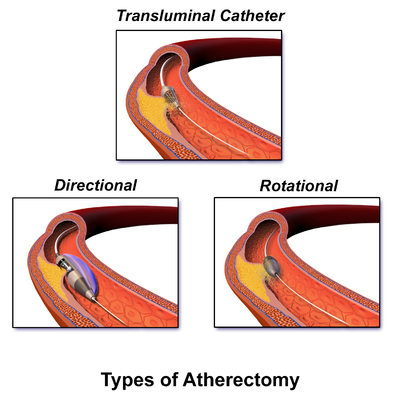Atherectomy
| Atherectomy | |
|---|---|
 Illustration of three types of atherectomy devices being used to remove plaque in a blood vessel | |
| ICD-9-CM | 39.50, 00.61 -00.62 |
| MeSH | D017073 |
Atherectomy is a minimally invasive endovascular surgery technique for removing atherosclerosis from blood vessels within the body. It is an alternative to angioplasty for the treatment of peripheral artery disease, but the studies that exist are not adequate to determine if it is superior to angioplasty.[1] It has also been used to treat coronary artery disease, albeit ineffectively.[2]
Uses
Atherectomy is used to treat narrowing in arteries caused by peripheral artery disease.
Technique
Unlike angioplasty and stents, which push plaque into the vessel wall, atherectomy cuts plaque from the wall of the artery. While atherectomy is usually employed to treat arteries it can be used in veins and vascular bypass grafts as well.
Atherectomy falls under the general category of percutaneous revascularization, which implies re-canalizing blocked vasculature via a needle puncture in the skin. The most common access point is near the groin through the common femoral artery (CFA). Other common places are the brachial artery, radial artery, popliteal artery, dorsalis pedis, and others.
There are four types of atherectomy devices: orbital, rotational, laser, and directional.
The decision to use which type of device is made by the interventionist, based on a number of factors. They include the type of lesion being treated, the physician's experience with each device, and interpretation of the devices' risks and effectiveness, based on a review of the medical literature.
See also
References
- ^ Ambler, GK; Radwan, R; Hayes, PD; Twine, CP (17 March 2014). "Atherectomy for peripheral arterial disease". The Cochrane Database of Systematic Reviews. 3 (3): CD006680. doi:10.1002/14651858.CD006680.pub2. hdl:1983/6accf27a-96bc-42b4-afe7-e385fe077f16. PMID 24638972.
- ^ Wasiak J, Law J, Watson P, Spinks A (December 2012). "Percutaneous transluminal rotational atherectomy for coronary artery disease". Cochrane Summaries.
